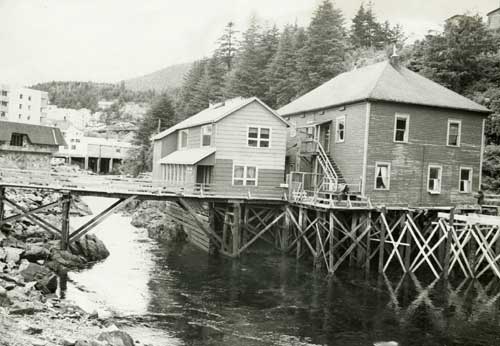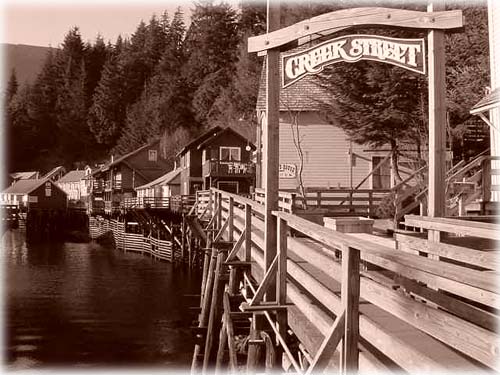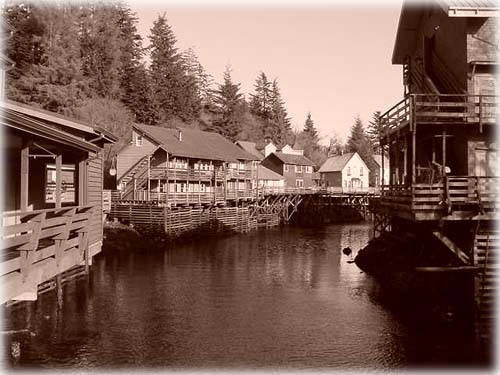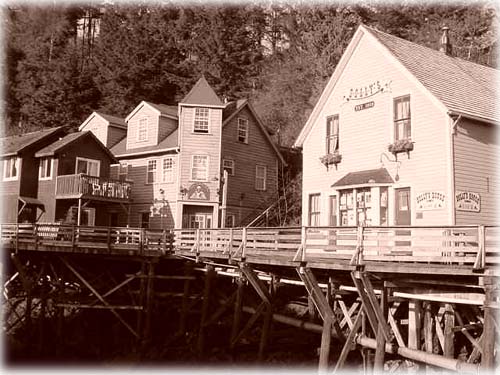 echoes of music from the past By June Allen February 21, 2004
 Photographer: Jim Clark Donor: Mildred Manty Estate, PhotoCourtesy Tongass Historical Society 78.9.5.356
But there was one Creek Street address that shone and shines above all other Creek Street addresses. It was the spacious and popular two-story Star dance hall and emporium of feminine delights at #5. At one time a small lighted star fashioned of naked light bulbs glimmered high on the east gable of the Star. Another small star of dark-colored wood was inlaid into the maple dance floor when the large addition to an older house was built sometime before 1914. The Star was the jewel of Ketchikan's glowing red light district. Back at the beginning of the 20th century, Ketchikan's city council had, whether it meant to or not, created an out-of-sight out-of-mind red-light district. With its new law and order powers, the fledgling city made every effort to rid busy dockside Front Street of prostitutes. So the wily working girls who rented rooms above the downtown saloons or card rooms simply moved a few hundred yards to the west and set up shop in Newtown! Then at the March 1903 meeting, city council was presented with a petition from Newtown residents, including former council member Dr. M.M. Hopkins, demanding that bawdy houses be removed from their neighborhood! The council and Mayor George Irving - a lawyer and partner in the Goldstream Mine on Gravina - then ordered that "Bawdy houses in New Town be moved to Indian town on the other side of the creek," meaning the upland side. Little houses began to go up on piling all along the rocky tidal banks of the creek. The Indians who lived there earlier chose to move to Saxman. One of those new houses was #5. Before it became the Star, it started out conventionally enough as a steeply gabled little house with two rooms and a kitchen downstairs and a narrow stairway that reached four small, slope-ceilinged rooms upstairs. Like other houses along the creek, its toilet emptied directly into Ketchikan Creek, which was fine at high tide but dreadful at low tide. So out-of-sight and out-of-mind was Creek Street that those sewage conditions lasted until the late 1960s! It's not known who owned the Star building before Mattie Wilkes bought it. Mrs. Wilkes and her adjacent neighbors, however, were identified on documents as being "female boarders" (prostitutes) who didn't use their real names anyway. Several of the lots to the east of #5 were occupied by a shingle mill and its outbuildings, but the next nine residential lots leading to Stedman Street were all labeled FBs, "female boarders." It probably was Mattie Wilkes who had the large addition made to the Star, the big dance hall. The original house's back door is still there, facing the bluff. So are the outlines of the original rooflines. Historical photos show that at first the big dance hall addition was flat-roofed. Later the hip roof was added. The new upstairs provided additional rooms for entertaining, plus an attic for storage.  Photo by Gigi Pilcher©
Black Mary invested her money in Ketchikan, owned a number of properties citywide and was a kind soul known to help those in need, according to the news items that followed her death in 1925. But Mary was no longer a young woman, feeling too tired to deal with police or referee the catfights among her girls - and her health was failing. So in 1924 Mary sold the Star to 32-year-old Thelma Baker. Less than a year after the sale, Black Mary died, a Ketchikan Chronicle story of May 9, 1925, reported. Cause of death, a doctor said, was "heart failure" probably caused by high blood pressure. The news story said Mary was found dead sitting in her chair at her Newtown home. However in a 1972 interview, an elderly Dolly Arthur said that she remembered it was a strangely pink morning when Mary was found dead in her armchair in a little house on Barney Way, the roll of bills she had been counting still in her lap. Even 47 years after her friend's death, Dolly's eyes filled with tears. Thelma Baker, the new owner of the Star, was not unknown in Ketchikan. Born Linda Ruth McCowan in 1892 in Washington state, she was also known as Linda Graham and but mostly by her Ketchikan "stage name" of Thelma Baker. She has been described as a thin mulatto woman with a good head for business. Thelma had come to the attention of the police and to a Chronicle reporter less than a year before she bought the Star when she was busted in a prohibition raid. The Sunday, Dec. 30, 1923, article reads:
"For Sale: One percolator. As the owner is going out of business this percolator will be sacrificed at just what it has cost the owner - $257.50. Thelma Baker, she of the percolated Rhoderic Dhu [Scotch whiskey] and erstwhile proprietress of the Bungalow, where Deputy Marshal Handy accidentally ran across a percolator filled with whiskey and a cold bottle of beer for the morning, appeared before the U.S. Commissioner yesterday afternoon and pleaded guilty to a violation of the Alaska bone dry law. She was fined $250.00. She liquidated."  Photo by Gigi Pilcher©
Actually, the alcohol trade and the Creek Street girls blossomed under the new bone dry law, in spite of occasional raids and the publicly embarrassing rides to the police station in the open benches of the Black Mariah, with the model T's siren blaring and honking the whole way. It was worth it. The more than profitable sale of alcohol was the prime draw along Creek Street during those dry years, the sex trade a sideline. The salmon boats still called at Alaska's First City, the halibut boats still stopped at Ketchikan with their crews of up to 15 men, and the stomp of fish-scale-crusted boots echoed nightly along the planks of Creek Street's boardwalk. The size of Thelma Baker's Star was bound to draw crowds, notoriety and sometimes brawls. It did. The Star had a piano to provide music for dancing as well as a phonograph to play the big wax records of popular singers and orchestras of the day. The girls danced, laughed, cuddled and personally "entertained" their customers - if the men were still sober enough. If not, their money for drinks alone was just fine. Thelma Baker kept a nice place and it wasn't long before it began to be called "Thelma's Place." But while business boomed along the Creek during the 1920s and survived even through the Depression of the '30s, there were people in Ketchikan who were not pleased with the activity along the Creek. The red-light district was tolerated for a very long while because the girls attracted the fishing fleets to Ketchikan, men who spent money for supplies and repairs etc. in the Canned Salmon Capital of the World. The girls themselves spent a great deal of money in Ketchikan - cash! But there was another side to the story. There also began to be drugs involved, brawls and occasional stabbings and a body or two found floating at the mouth of the creek. Times were changing and eventually the Creek would have to change with them. There were temporary closures of prostitution in Ketchikan over the years and it always gradually returned in a matter or weeks or months. But Creek Street, the Star and the entire city for that matter were all off-limits to prostitutes for the entire four years of World War II. But the girls gradually edged back in. By 1946 the problem was not limited to Creek Street but spread throughout the city. City officials looked the other way until events forced them to make an end to the problem that had divided the town for years. Prostitution was ended for good in the fall of 1953. Creek Street lay largely quiet and comparatively unoccupied for years, with the little houses rented out and the larger ones like the Star providing space to let. Thelma Baker remained alone in her oversized house, part of it boarded up. For a short time in the 1960s the Star housed a woodworking shop on the first floor. Then on the morning of August 7, 1972, smoke was seen escaping from the roof of Thelma's Place at #5 Creek Street. Firemen broke in and found that the fire had started in Thelma's apartment and smoldered for perhaps four or five hours before being discovered. News reports indicated that Thelma had apparently been trying to start a fire in her oil stove when it flared out of control and set her afire. Among firemen responding to the alarm were volunteers Dave O'Sullivan (later fire chief), and young Ralph G. Bartholomew. Fireman Jim Auger found Thelma's body in the passageway between the parlor and the kitchen. Her little black dog was found dead from smoke inhalation in a corner sewing room where he had hidden under a sewing table. Thelma Baker's body was flown to Anchorage for autopsy and then cremated. Her memorial service was held in Ketchikan August 15. Thelma Baker was 80 years old at the time of her death. Annie Watkins had died in January of 1966, and Thelma Baker in August of 1972. Then there was only Dolly Arthur left on the Creek, ill, almost blind with cataracts, but still paying her own way until the day she died in 1975. They were tough old birds, those 'girls.'  Photo by Gigi Pilcher©
Today the Star houses a book store and art galleries. In the winter awaiting summer and the hordes of tourists - Creek Street is silent, wet and empty except for the pedestrians passing en route to the Cape Fox Lodge tramway. A century ago the boardwalk was also mostly silent during those months when fishing had ended in the fall and before it opened again in the spring. The Girls vacationed down south or hunkered in for the winter with their pets, needlework and the occasional local gentleman caller. The creek level still rises and falls with the tides like it always did and the rain dependably pounds on rooftops, raincoats and umbrellas. And if you stand very quietly inside the Star building on that polished maple floor, you can almost catch the fragrance of the girls' powder and perfume and the wet wool and tobacco smell of their visitors. Close your eyes and maybe you can hear the soft strains of "Sleepy Time Gal." More likely you'll be able to listen hard and identify Eddie Cantor belting out "Makin' Whoopee!"
Special thanks to Karla
Sunderland at the Historical Museum for sharing a couple of clippings
about Thelma Baker!
june@sitnews.org
All rights reserved. Not to be reprinted in any form without the written permission of June Allen.
|
|||||||





